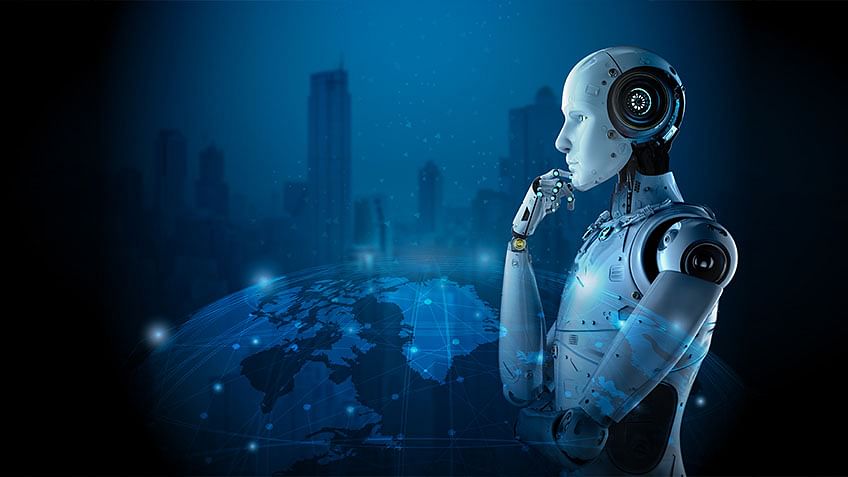Artificial Intelligence: Transforming the Future of Technology and Society
the future hold for this rapidly advancing field? In this article, we’ll explore the fundamentals of AI, its types, real-world applications, ethical considerations, and what the future of AI might look like.
Artificial Intelligence (AI) has emerged as one of the most powerful and transformative forces of the 21st century. From healthcare and education to business, entertainment, and transportation, AI is reshaping industries, revolutionizing how we interact with technology, and altering the way society functions. But what exactly is AI? How does it work? And what does

1. What is Artificial Intelligence?
Artificial Intelligence refers to the simulation of human intelligence in machines that are programmed to think, learn, and problem-solve. AI systems are designed to mimic human cognitive functions, such as perception, reasoning, learning, and decision-making. These systems are powered by algorithms and data that enable them to perform tasks that traditionally required human intelligence.
AI can be classified into two broad categories:
Narrow AI (Weak AI): This is the most common form of AI today. Narrow AI is designed to perform specific tasks, such as facial recognition, voice assistants, or recommendation algorithms. These systems are highly specialized but lack the ability to perform tasks outside their designated functions.
General AI (Strong AI): General AI refers to machines that possess the ability to perform any intellectual task that a human can do. This level of AI is still theoretical and has not been realized yet. General AI would require machines to have human-like cognitive abilities and the capacity for consciousness, which remains a subject of research and debate.
2. How AI Works
AI operates through a combination of several technologies and methodologies. Some of the key components that make AI possible include:
Machine Learning (ML): ML is a subset of AI that focuses on building systems that can learn from and make predictions based on data. These systems improve over time as they are exposed to more data, without the need for explicit programming. There are different types of machine learning:
Supervised learning: The algorithm learns from labeled data, where both the input and output are provided.
Unsupervised learning: The algorithm identifies patterns in data without being provided with labeled outcomes.
Reinforcement learning: The system learns by interacting with its environment and receiving feedback in the form of rewards or penalties.
Neural Networks: These are algorithms inspired by the human brain, designed to recognize patterns and interpret data in layers. Deep learning, a subset of machine learning, uses large neural networks to process vast amounts of data and make highly accurate predictions.
Natural Language Processing (NLP): NLP enables AI systems to understand, interpret, and generate human language. It powers applications like chatbots, language translation, and voice assistants.
Computer Vision: This technology enables AI to interpret and make decisions based on visual input, such as recognizing objects in images or videos. It is widely used in facial recognition, autonomous vehicles, and medical imaging.
3. Applications of AI Across Industries
The impact of AI can be seen across numerous industries. Here are some of the key applications:
Healthcare: AI is revolutionizing healthcare by improving diagnostics, personalizing treatment plans, and speeding up drug discovery. AI-powered systems can analyze medical images, predict patient outcomes, and even suggest the best course of treatment. For example, IBM Watson Health uses AI to analyze large datasets of medical literature and patient records to assist doctors in making more informed decisions.
Business and Finance: AI is helping businesses improve customer service, optimize operations, and make data-driven decisions. Financial institutions use AI for fraud detection, credit scoring, algorithmic trading, and customer support. In e-commerce, recommendation algorithms (like those used by Amazon and Netflix) analyze consumer behavior to suggest products or content tailored to individual preferences.
Transportation: Autonomous vehicles, powered by AI, are set to revolutionize the way we travel. AI systems can process data from sensors, cameras, and maps to navigate and control self-driving cars. AI is also used to optimize traffic flow, improve logistics, and enhance fleet management.
Retail: In retail, AI enhances the customer experience by personalizing marketing efforts, managing inventory, and predicting demand. Chatbots, powered by AI, offer 24/7 customer service, while AI-based supply chain management helps retailers optimize delivery routes and reduce costs.
Entertainment: AI plays a significant role in content recommendation, gaming, and media production. Platforms like Netflix and YouTube use AI to recommend shows or videos based on a user’s viewing history. In video games, AI-powered non-player characters (NPCs) can react and adapt to player behavior, creating more immersive experiences.
Manufacturing and Robotics: AI-driven robots are used in factories to automate repetitive tasks, assemble products, and manage logistics. Machine learning helps optimize production lines, predict equipment failures, and reduce waste.
4. Ethical Considerations and Challenges
While AI holds great potential, its rapid growth also raises several ethical concerns and challenges:
Job Displacement: One of the biggest concerns with AI is its impact on employment. As machines and algorithms automate more tasks, there is a risk that human workers could be displaced, especially in industries like manufacturing, transportation, and customer service. The future of work may require significant investment in reskilling and upskilling the workforce to adapt to new roles.
Bias and Fairness: AI systems are only as good as the data they are trained on. If the data used to train AI algorithms is biased, the system can reinforce existing inequalities. For instance, facial recognition technology has been criticized for higher error rates when identifying people of color. Ensuring that AI systems are fair, transparent, and accountable is a key challenge.
Privacy and Security: As AI systems become more integrated into daily life, concerns about data privacy and security are growing. AI-powered surveillance, data collection, and decision-making systems can infringe on personal privacy. Protecting sensitive data and ensuring that AI systems are secure against cyberattacks is crucial.
Autonomy and Accountability: The question of who is responsible when an AI system makes a mistake or causes harm is another ethical dilemma. For instance, in the case of self-driving cars involved in accidents, determining liability—whether it lies with the car manufacturer, the software developer, or the vehicle owner—is complex.
Existential Risks: The development of superintelligent AI—machines with cognitive abilities far exceeding human intelligence—raises concerns about long-term risks. Some experts warn that without proper safeguards, advanced AI could pose existential threats to humanity. Ensuring that AI is developed safely and responsibly is a topic of active research.
5. The Future of AI
The future of AI holds immense promise but also significant challenges. In the next decade, we can expect AI to:
Become More Integrated into Everyday Life: AI will continue to evolve from specialized tools to ubiquitous systems embedded in all aspects of life—from personal assistants to smart cities and healthcare.
Drive Innovation: AI is expected to play a key role in solving complex problems, from combating climate change and improving healthcare to advancing scientific research and creating new art forms.
Human-AI Collaboration: Rather than replacing humans, AI will increasingly work alongside people to augment their abilities. AI-driven tools will help professionals in fields like law, medicine, and design make more informed decisions and boost productivity.
Ethical Governance: As AI continues to grow, the importance of establishing international regulations and ethical frameworks will increase. Ensuring that AI is developed and used responsibly will be essential for ensuring its benefits are distributed equitably and safely.
AI in Creativity: AI’s role in creative industries will continue to expand. From generating art and music to writing stories and designing products, AI is enabling new forms of creative expression that were previously unimaginable.
Know more about NumGenius and AI Working
6. Conclusion
Artificial Intelligence is rapidly becoming a transformative force across every industry, offering unprecedented opportunities for innovation, efficiency, and progress. While AI presents significant benefits, it also brings challenges that need to be addressed in a responsible, ethical manner. As AI technologies evolve, society must ensure they are developed and deployed in ways that benefit all people, enhance quality of life, and minimize risks.
The future of AI is not only about machines doing tasks autonomously but about how we, as humans, collaborate with AI to solve problems, enhance creativity, and create a more efficient and sustainable world. The ongoing dialogue about the ethical implications, the societal impact, and the potential of AI will shape its future and our collective future in profound ways.
What's Your Reaction?
 Like
0
Like
0
 Dislike
0
Dislike
0
 Love
0
Love
0
 Funny
0
Funny
0
 Angry
0
Angry
0
 Sad
0
Sad
0
 Wow
0
Wow
0


















































